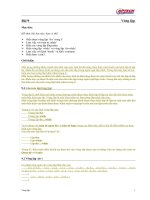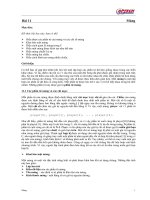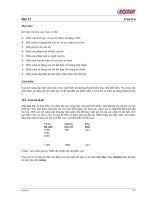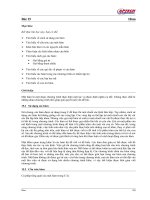Computer concept 2018 module04
Bạn đang xem bản rút gọn của tài liệu. Xem và tải ngay bản đầy đủ của tài liệu tại đây (6.61 MB, 107 trang )
Computer Concepts 2018
Module 4
The Web
Copyright © 2019 Cengage. All rights reserved.
Module Contents
•
•
•
•
•
Section A: Web Basics
Section B: Browsers
Section C: HTML
Section D: HTTP
Section E: Search Engines
Copyright © 2019 Cengage. All rights reserved.
Section A: Web Basics
•
•
•
•
•
Web Overview
Evolution
Web Sites
Hypertext Links
URLs
Copyright © 2019 Cengage. All rights reserved.
Section A: Objectives (1 of 3)
• List the four essential technologies that are the
foundation of the World Wide Web
• Summarize the key events in the emergence of the
modern Web
• Draw a diagram showing the hierarchy of the following:
Web server, Web sites, Web pages, hypertext links
Copyright © 2019 Cengage. All rights reserved.
Section A: Objectives (2 of 3)
• Describe a situation in which bidirectional hypertext
links would improve your online research experience
• Give an example of the URL for a Web site home page,
one for a Web page that is stored in a folder, and one
for a Web page that is produced based on a query
Copyright © 2019 Cengage. All rights reserved.
Section A: Objectives (3 of 3)
• State four rules for correctly typing URLs
• Define the term linkrot
• Describe a situation in which you might use a short URL
service
• Explain the difference between a URL and a domain
name
Copyright © 2019 Cengage. All rights reserved.
Web Overview (1 of 2)
• The Web is not the Internet
• The Internet is a global data communications network
• The Web is just one of the many technologies that use
the Internet to distribute data
Copyright © 2019 Cengage. All rights reserved.
Web Overview (2 of 2)
• The World Wide Web
(usually referred to
simply as the Web) is a
collection of HTML
documents, images,
videos, and sound files
that can be linked to
each other and
accessed over the
Internet using a protocol
called HTTP
Copyright © 2019 Cengage. All rights reserved.
Evolution (1 of 4)
• In 1993 there were a total of 130 Web sites; by 1996
there were 100,000 Web sites
• Today, there are more than a billion Web sites and new
sites appear every day
• Ted Nelson coined the term hypertext to describe a
computer system that could store literary documents,
link them in logical relationships, and allow readers to
comment and annotate on what they read
Copyright © 2019 Cengage. All rights reserved.
Evolution (2 of 4)
Ted Nelson sketched his vision for project Xanadu in the 1960s.Notice his
use of the terms web and links, Which are now familiar to everyone who uses
the World Wide Web.
Copyright © 2019 Cengage. All rights reserved.
Evolution (3 of 4)
• In 1990 British scientist Tim Berners-Lee developed
specifications for URLs, HTML, and HTTP — the
foundation technologies of today’s Web
• Berners-Lee created the Web browser software
Nexus
• In 1993 Marc Andreessen at the University of Illinois
created the Web browser Mosaic that led to the
development of the popular browser Netscape
Copyright © 2019 Cengage. All rights reserved.
Evolution (4 of 4)
Copyright © 2019 Cengage. All rights reserved.
Web Sites (1 of 2)
• A Web site typically contains a collection of related
information organized and formatted so it can be
accessed using a browser
• A Web server is an Internet-based computer that stores
Web site content and accepts requests from browsers
• A Web page is based on an HTML source document
that is stored as a file on a Web server
Copyright © 2019 Cengage. All rights reserved.
Web Sites (2 of 2)
Copyright © 2019 Cengage. All rights reserved.
Hypertext Links (1 of 2)
• Web pages are connected by hypertext links
(commonly referred to simply as links)
• Links are commonly indicated by the underlined or
colored text, a photo, button, tab, or object
Copyright © 2019 Cengage. All rights reserved.
Hypertext Links (2 of 2)
• Web pages have
unidirectional links;
Document A links to
Document B, but not
vice versa
• Bidirectional links
connect two documents
using a two-way link
that can be followed
from either document
Copyright © 2019 Cengage. All rights reserved.
URLs (1 of 7)
• Every Web page has a unique address called a URL
(Uniform Resource Locator, pronounced “you are
ELL”)
• Most URLs begin with http:// to indicate the Web’s
standard communications protocol
• The file name of a specific Web page always appears
last in the URL
Copyright © 2019 Cengage. All rights reserved.
URLs (2 of 7)
• Some URLs contain a search string rather than the
name of an HTML document
Copyright © 2019 Cengage. All rights reserved.
URLs (3 of 7)
• Rules for correctly typing a
URL:
– A URL never contains spaces
– The http:// can be omitted
– Always use a forward slash
(/)
– Duplicate the URL’s
capitalization exactly —some
Web servers are case
sensitive
– Links aren’t URLs, but a link
contains the URL that “links”
to another Web page
Copyright © 2019 Cengage. All rights reserved.
URLs (4 of 7)
• Many URLs are long and complex; this can be a
problem
• Several services, such as Bitly and Goo.gl, create short
URLs
1. Copy and paste the full URL into the box provided by a
short URL service such as Goo.gl.
2. The service produces a short URL.
3. The short URL is stored on the server along with the
full URL.
4. Links to the short URL are directed to the server, which
forwards the link to the full URL
Copyright © 2019 Cengage. All rights reserved.
URLs (5 of 7)
Copyright © 2019 Cengage. All rights reserved.
URLs (6 of 7)
• Short URL services may lead consumers to believe that
all short URLs will last forever
• Short URLs are sometimes used to disguise the real
address of a Web site that is illegitimate
• Short URL services may be blocked by Web hosts and
ISPs
• Web surfers should be aware that short URLs may lead
to questionable Web sites and scams
Copyright © 2019 Cengage. All rights reserved.
URLs (7 of 7)
Copyright © 2019 Cengage. All rights reserved.
Section B: Browsers
• Browser Basics
• Customization
• Browser Cache
Copyright © 2019 Cengage. All rights reserved.
Section B: Objectives (1 of 2)
• Identify the following elements of a browser window:
address box, refresh and home buttons, back and
forward buttons, tabs, and settings menu
• List four popular browsers
• State the difference between the default browser and
the browser home page
Copyright © 2019 Cengage. All rights reserved.









